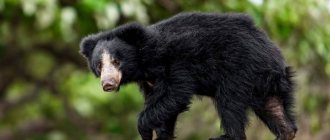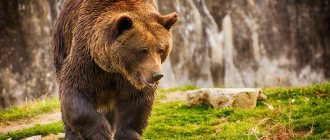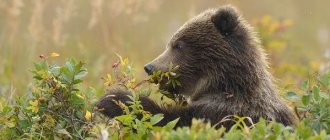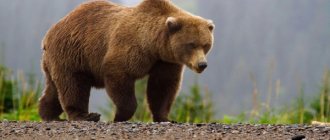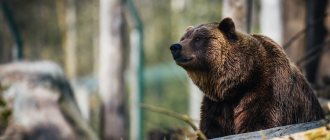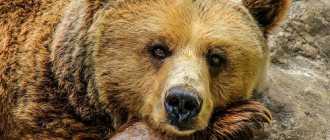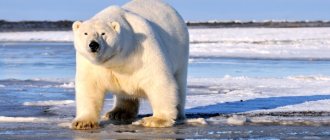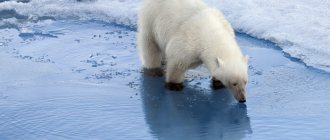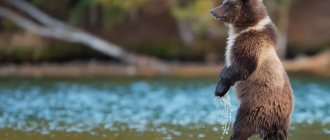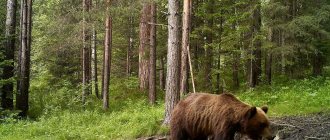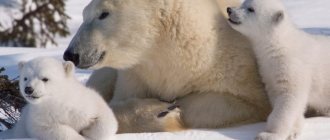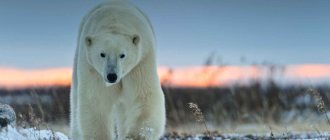The most common types of bears
- white;
- brown;
- black.
They are big and scary, and the question “how much does a bear weigh?” is probably interesting. It's hard to imagine that when he is born, the bear weighs 200 grams. As for the adult, the situation is completely different.
The brown bear is the national animal of Finland. It is most common there. Often found in Scandinavia. Previously, the situation was different . This species lived throughout almost all of Europe, in England, Ireland, in the African mountains and even in Japan, and lived in Alaska and Mexico. The brown one lives in almost all forest belts of the Russian Federation, except for the southern ones.
A brown bear has thick withers on its back
The bear looks aggressive and incredibly strong. He has thick fur and has withers on his back. Evenly colored. Shedding occurs only in the spring, and in the fall they already appear with renewed fur. They have:
big head;- small ears;
- deep-set eyes.
The hidden tail is difficult to see with the naked eye. Its length is only 2 centimeters . The paws are powerful with hooked claws. They grow up to 10 centimeters. In general, it is not surprising why these animals inspire fear.
What does a polar bear eat?
The polar bear feeds exclusively on meat and fish. Its victims include seals, ringed seals, bearded seals, walruses, beluga whales and narwhals. Having caught and killed the prey, the predator begins to eat its skin and fat. This part of the carcass is what polar bears eat in most cases. They prefer not to eat fresh meat, making an exception only during periods of prolonged hunger strikes. Such a nutritious diet is necessary for the accumulation of vitamin A in the liver, which helps to survive a long winter without consequences. What the polar bear does not eat is picked up by the following scavengers - arctic foxes and wolves.
To satiate, a predator needs at least 7 kilograms of food. A hungry bear can eat 19 kilograms or more. If the prey is gone and there is no strength left to pursue it, then the animal feeds on fish, carrion, bird eggs and chicks. At such times, the bear becomes dangerous to humans. He wanders to the outskirts of villages, feeding on garbage and tracking down lonely travelers. In hungry years, bears also do not disdain algae and grass. Periods of long hunger strikes mainly occur in the summer, when the ice melts and retreats from the shore. At this time, the bears are forced to spend their own fat reserves, sometimes starving for over 4 months in a row. The question of what a polar bear eats becomes irrelevant during such periods, since the animal is ready to feed on literally everything that moves.
The largest species recorded in Kamchatka
The height of a brown bear reaches two meters. The largest species live in Kamchatka, the Far East and Alaska. Standing, their height is about three meters. How much does a brown bear weigh? It depends on some factors:
- from the floor;
- from age;
- from the habitat.
As a rule, the largest individuals are males. Females are slightly smaller than them. They can weigh from 90 kg to 210 kg. The weight of an adult brown bear, a male, ranges from 140 kg to 400 kg. There are exceptions. For example, some individuals can reach 600 kg. A real giant was found on one island; you can hardly guess how much it weighed. One has only to marvel at its greatness; it reached a mass of 1,134 kg and was about 4 meters in height.
In Russia, such large animals are not found. The dimensions of these animals are slightly smaller. For example, the brown grizzly bear subspecies weighs about 500 kg; as an exception, it can reach 700 kg. Average individuals weigh about 100 kg.
White Northerner
You can’t immediately determine how much a polar bear weighs. In appearance, it looks smaller than its brown and black relatives. Mostly white animals live in the snowy northern latitudes of our Planet. This species is widespread in the Arctic. Females reach a body weight of 300 kg, but males are almost twice as large. Their weight ranges from 350 kg to 450 kg. So white relatives are no less than their heat-loving brothers. There are also white individuals that can weigh half a ton. Therefore, polar bears, no matter how much they weigh, are not less, but even more than brown ones. Features of white animals:
- have a length of up to 3 meters;
- covering coat is off-white;
- the paw span is more than 3 meters.
A tall person would be just over the shoulder of a polar bear. When he stands on his hind legs, he becomes very dangerous. Despite the fact that these northern inhabitants look white, their skin is black. Their white fur is transparent to the sun.
The color of the white inhabitants allows them to camouflage well in the snow. This beast, with its weight, height and paw span, is a serious fighter with whom it is better not to joke.
Where does the polar bear live?
The polar bear lives exclusively in the subpolar regions of the northern hemisphere, but this does not mean that the animal lives everywhere where there is non-melting Arctic snow. Most bears do not go further than 88 degrees north latitude, but the extreme point of their distribution in the south is the island of Newfoundland, the few inhabitants of which risk their lives every day trying to get along with a dangerous predator.
Residents of the Arctic and tundra zones of Russia, Greenland, the USA and Canada are also familiar with the polar bear. Most animals live in areas with drifting, multi-year ice, where many seals and walruses also live. Most often, the bear can be seen near a large hole, on the edge of which it freezes in anticipation of a seal or fur seal rising from the depths.
It is impossible to accurately determine the continent where the polar bear lives. The most extensive populations of these animals were named after the location of their main concentration. So, most predators prefer:
- the eastern shores of the Kara and East Siberian seas, the cold waters of the Laptev Sea, the New Siberian Islands and the Novaya Zemlya archipelago (Laptev population);
- the shores of the Barents Sea, the western part of the Kara Sea, the islands of the Novaya Zemlya archipelago, Franz Josef Land and Spitsbergen (Kara-Barents Sea population);
- Chukchi Sea, northern Bering Sea, eastern East Siberian Sea, Wrangel and Herald Islands (Chukchi-Alaskan population).
Directly in the Arctic, polar bears are rarely found, preferring more southern and warmer seas, where they have a better chance of survival. The habitat is variable and is associated with the boundaries of polar ice. If the Arctic summer drags on and the ice begins to melt, then animals move closer to the pole. With the onset of winter, they return to the south, preferring ice-covered coastal areas and the mainland.
Life routine of bears
But how long this animal will live depends on many factors. If he lives in his usual conditions until he is 35 years old. If he lives in a zoo or nature reserve for about 50 years, and sometimes longer. At 6 or 11 years of age it is already mature.
As for brown forest inhabitants, they have an excellent sense of smell and hearing. They can smell meat from a considerable distance. They are excellent hunters. To hear and smell the victim, they rise on their hind legs and listen carefully. In general, for bears their habitat is a kingdom, and in it they feel like kings. Early in the morning and in the evening they inspect their place of residence. When the weather is bad, they like to hunt.
Bears are forest dwellers. They especially love dense thickets rich in deciduous trees. Males prefer to live alone, and females prefer to live with their cubs. Males need an area almost seven times larger than females. Bears mark the beginning and end of their territory with urine and scratches on trees.
They eat everything. They mainly love vegetation - nuts, acorns, berries. When the harvest is bad they can eat corn and oats. Bears also eat insects and rodents - mice, gophers. Easily kill an elk. It happened that bears attacked wolves , Himalayan bears and even tigers. And despite all this, they are not natural predators. Most of all, bears love honey and fish. During the spawning period, it eats the entire carcass, and when the reservoir is teeming with aquatic inhabitants, it eats heads, milk and caviar. If the bear is hungry, it may attack apiaries in search of honey. Features of bears:
- active in the morning and evening;
- By winter it gets fat and goes into hibernation;
- sleeps for almost 190 days in winter.
Clubfoots spend almost half a year in hibernation. The location of the den is the rhizome of trees. Of course, after hibernation the bears will weigh less. They lose almost 80 kilograms of their own weight. But, after waking up, they begin to look for food for themselves.
Such individuals are called connecting rods. They are hungry, and therefore considered quite dangerous , even when they weigh less. Therefore, if you meet a clubfoot during this period, you cannot escape him.
It is impossible for connecting rods to survive until spring. They die from frost, starvation or from hunters.
Bears look clumsy, however, this is deceiving. After all, they are excellent runners and swimmers and move well through trees. With one blow, their paws can break a large artiodactyl.
The offspring of clubfoot
The clumsy forest dwellers produce offspring every few years. Estrus occurs approximately at the very beginning of the summer period. Lasts about four weeks. When bears reproduce, males begin to fight with each other , sometimes beating their own kind to death. Females usually mate with several partners. Pregnancy lasts up to 8 months. Mother bears give birth in dens. During one birth, about 5 babies are born. They are only 25 centimeters long. Cubs at birth:
- weigh no more than 680 grams;
- are born blind and deaf;
- there is practically no wool.
Bear cubs begin to hear only 14 days after their birth. And vision occurs in newborns after 30 days . When they are three months old, the first incisors emerge, which babies use to eat berries. They feed on their mother's milk for more than three years. Unfortunately, males can even eat the cub.
Features of character and lifestyle
The polar bear is considered a cruel predator that even attacks people. The animal prefers a solitary lifestyle; males and females gather together only during the rutting period. The rest of the time, bears move exclusively through their own territory, conquered from their other brothers, and this applies not only to males, but also to females with newborn offspring.
Hibernation
Unlike its brown counterparts, the polar bear does not have to hibernate for the winter. Most often, only pregnant females sleep on the eve of giving birth. Adult males do not sleep every season; the duration of hibernation is no more than 80 days (a brown bear sleeps from 75 to 195 days a year).
Reproduction of polar bears, care of offspring
Polar bears behave quite peacefully towards each other; most fights occur between males during the rutting period. At this time, not only adult animals can suffer, but also cubs, which prevent the female from re-participating in mating games.
Animals become sexually mature when they reach 4 or 8 years of age, while females are ready to bear offspring 1-2 years earlier than males.
The mating season lasts from late March to early June. One female can be pursued by up to 7 males. Gestation of offspring takes at least 250 days, which corresponds to 8 months. Pregnancy begins with a latent stage, which is characterized by a delay in embryo implantation. This feature is associated not only with the physiology of the animal, but also with its living conditions. The female must prepare for fetal development and long hibernation. Around the end of October, she begins to equip her own den, and for this purpose sometimes travels hundreds of kilometers. Many females dig dens near existing buildings. Thus, on the Wrangel and Franz Josef islands there are at least 150 closely located dens.
Embryo development begins in mid-November, when the female is already sleeping. Its hibernation ends in April and at about the same time 1-3 cubs, weighing from 450 to 700 grams each, appear in the den. The exception is the birth of 4 cubs. The babies are covered with thin fur, which practically does not protect them from the cold, therefore in the first weeks of their life the female does not leave the den, maintaining her existence at the expense of accumulated fat.
Newborn cubs feed exclusively on mother's milk. They do not open their eyes immediately, but a month after birth. Two-month-old babies begin to crawl out of the den, only to leave it completely when they reach 3 months. At the same time, they continue to feed on milk and stay close to the female until they reach 1.5 years. Small cubs are practically helpless, so they often become prey for larger predators. The mortality rate among polar bears under 1 year of age is at least 10-30%.
A new pregnancy in a female occurs only after the death of the offspring, or their introduction into adulthood, that is, no more than once every 2-3 years. On average, no more than 15 cubs are born from one female during her entire life, half of which die.
Siberian brown bear - a resident of Siberia who does not like honey
The claws of the Siberian brown bear are strongly curved, up to 8.5 cm long.
Another large subspecies living in Russia is the Siberian brown bear. It is slightly smaller in size than the Japanese and Kamchatka, but some individuals can be compared with them in size. The maximum recorded weight reached 350 kg. It has a powerful body, a large head, strong paws with curved sharp claws, the length of which is approximately 8.5 cm. The color of the coat is dark brown, sometimes with a yellowish or black tint.
The behavior is similar to the lifestyle of other subspecies. These animals live in the forest zone, preferring solitude. But when the salmon spawning season begins, the animals gather near rivers, where they catch fish jumping out of the water. Fish is an important component of their diet; in addition, they eat various berries, rhizomes, plant shoots, and often hunt forest inhabitants: hares, deer, moose, but they do not really like honey. They hibernate during the winter.
The mating season begins in the summer. Cubs are born in winter, during hibernation. Typically, a female has from one to three babies. She takes care of the cubs on her own until they are 3 years old. Next to the female there can be cubs of different ages at the same time; the older ones usually help raise the younger ones.
Siberian bears live throughout much of Eastern Siberia and are also found in China, Kazakhstan and Mongolia. They are almost not wary of people and often destroy hunting lodges in search of food.
Second generation of hybrid bears in nature
The polar-brown bear hybrid made a splash in 2006, but the aknuk became even more famous in 2010. A hunter on Victoria Island shot what he believed was a polar bear. After studying the DNA, it became clear that the mother of this individual was a hybrid, and the father was an ordinary grizzly bear.
The character and behavior of aknuk are more similar to those of polar bears, but some features are still borrowed from brown bears.
The Department of Environmental Conservation has officially announced that the first second-generation Grolar has been discovered in the wild. It was decided to call hybrids pizzly and nanulaki if the mother is a grizzly bear and the father is a polar bear, and to call them grolar or aknuk when the mother is a polar bear and the father is a grizzly bear.
If you find an error, please select a piece of text and press Ctrl+Enter.
